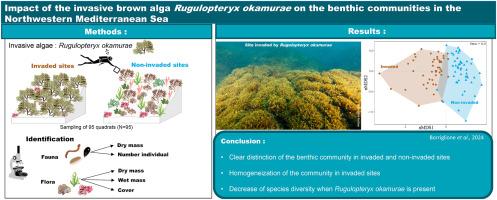Impact of the invasive brown alga Rugulopteryx okamurae on the benthic communities in the Northwestern Mediterranean Sea
IF 2.6
3区 地球科学
Q1 MARINE & FRESHWATER BIOLOGY
引用次数: 0
Abstract
Over the centuries, the Mediterranean Sea has been significantly impacted by biological invasions, hosting more than 1000 non-indigenous species. In the early 2000s, the brown alga Rugulopteryx okamurae, native to the northwestern Pacific Ocean, was introduced to the Thau Lagoon (Occitania, France) due to extensive shellfish farming activities. Since 2016, this species has proliferated, completely covering the rocky habitats along the Marseille coasts (Provence, France) and becoming the dominant alga. The impact of R. okamurae on flora and fauna was investigated by comparing rocky benthic assemblages of invaded and non-invaded sites. Results showed a change in the communities, with a significant decrease in species diversity and a homogenization of algal and invertebrate populations in invaded sites. Rugulopteryx okamurae is a habitat transformer species inducing a significant habitat shift. Rugulopteryx okamurae also seems to affect the different algal strata of the benthic community, thus impacting the entire canopy. However, a weak effect of R. okamurae was observed on the functional structure of native algal communities, comparing invaded and non-invaded areas. This lack of structural variation between these zones could be explained by the degradation of habitats within the Calanques National Park, due to decades of intense overgrazing by Sarpa salpa and sea urchins.
But an impact on the ecosystem functioning should not be excluded. It is noteworthy that R. okamurae, a species presumed to prefer colder waters, has shown resistance to successive marine heat waves, allowing it to continue spreading and dominating without impairment.

入侵褐藻 Rugulopteryx okamurae 对地中海西北部底栖生物群落的影响
几个世纪以来,地中海受到生物入侵的严重影响,有 1000 多种非本地物种栖息于此。本世纪初,由于广泛的贝类养殖活动,原产于太平洋西北部的褐藻 Rugulopteryx okamurae 被引入 Thau泻湖(法国奥克西塔尼亚)。自 2016 年以来,该物种大量繁殖,完全覆盖了马赛海岸(法国普罗旺斯)的岩石栖息地,并成为主要藻类。通过比较入侵和未入侵地点的岩石底栖生物群落,研究了 R. okamurae 对动植物群落的影响。结果表明,入侵地点的群落发生了变化,物种多样性显著减少,藻类和无脊椎动物种群趋于单一。Rugulopteryx okamurae是一种生境转换物种,会引起生境的显著变化。黄冠陆蝽似乎还会影响底栖生物群落的不同藻类层,从而影响整个冠层。不过,通过比较入侵区和非入侵区,可以发现褐飞虱对本地藻类群落的功能结构影响较弱。这些区域之间缺乏结构性差异的原因可能是,由于几十年来沙巴藻(Sarpa salpa)和海胆的过度放牧,卡兰克斯国家公园(Calanques National Park)内的栖息地退化了。值得注意的是,奥卡穆拉海胆(R. okamurae)这一被认为喜欢寒冷水域的物种,在连续的海洋热浪中表现出了抵抗力,使其能够继续扩散并占据主导地位而不受影响。
本文章由计算机程序翻译,如有差异,请以英文原文为准。
求助全文
约1分钟内获得全文
求助全文
来源期刊
CiteScore
5.60
自引率
7.10%
发文量
374
审稿时长
9 months
期刊介绍:
Estuarine, Coastal and Shelf Science is an international multidisciplinary journal devoted to the analysis of saline water phenomena ranging from the outer edge of the continental shelf to the upper limits of the tidal zone. The journal provides a unique forum, unifying the multidisciplinary approaches to the study of the oceanography of estuaries, coastal zones, and continental shelf seas. It features original research papers, review papers and short communications treating such disciplines as zoology, botany, geology, sedimentology, physical oceanography.

 求助内容:
求助内容: 应助结果提醒方式:
应助结果提醒方式:


